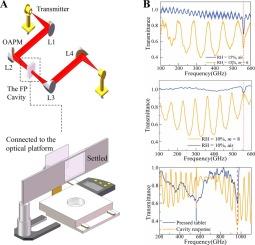基于法布里-佩罗腔的太赫兹频域光谱增强检测方法
IF 4.3
2区 化学
Q1 SPECTROSCOPY
Spectrochimica Acta Part A: Molecular and Biomolecular Spectroscopy
Pub Date : 2024-10-20
DOI:10.1016/j.saa.2024.125293
引用次数: 0
摘要
本文展示了一种简单、高效、低成本的气体检测方法,用于检测太赫兹范围内具有吸收峰的气体。本文设计了一个可调节模式的法布里-佩罗腔。通过调节腔体的长度,腔体的中心谐振频率可以耦合到气体吸收峰。这种耦合可以大大提高气体探测能力。为了探测气体吸收峰,我们选择了太赫兹频域光谱(THz-FDS),其频率分辨率可达 MHz 级。选择蒸汽来验证耦合现象。腔体的谐振频率被修改为耦合到 0.56 太赫兹,即蒸汽的吸收峰。实验在不同的湿度水平下进行,湿度由过饱和盐溶液控制。结果表明,在湿度为 15% 时,耦合效应可将水蒸气的可探测性提高约 167%,而随着湿度的增加,这种提高效应会逐渐减弱。我们分析了不同模式对耦合的影响,发现高模式可以使耦合更容易,但对增强效果影响不大。此外,该方法还用于检测生物大分子-α-酪氨酸,以确保其具有广泛的适用性。该方法可用于检测在太赫兹机制下具有吸收峰的物质,尤其是低浓度气体。本文章由计算机程序翻译,如有差异,请以英文原文为准。

The enhancement detection method based on the Fabry–Pérot cavity using terahertz frequency-domain spectroscopy
This article demonstrates a simple, efficient, and low-cost gas detection method for gases with absorption peaks in the terahertz range. A modes-adjustable Fabry–Pérot cavity is designed. By adjusting the length of the cavity, the center resonant frequency of the cavity can be coupled to the gas absorption peak. This kind of coupling can greatly enhance gas detection. To detect gas absorption peaks, we choose terahertz frequency domain spectroscopy (THz-FDS), whose frequency resolution can be up to the MHz level. Vapor is selected to verify the coupling phenomenon. The resonant frequency of the cavity is modified to couple to 0.56 THz, the absorption peak of vapor. Experiments are conducted at different humidity levels, the humidity is controlled by the supersaturated salt solution. Results indicate that at a humidity level of 15 %, the coupling effect can enhance the detectability of vapor by approximately 167 %, and this enhancement effect diminishes as humidity increases. We analyze the effect of different modes on the coupling and find that the high modes can make the coupling easier, but have little effect on the enhancement. Furthermore, the method is used to detect biomolecule-α-tyrosine to ensure it has wide applicability. This method can be used to detect substances with absorption peaks in the THz regime, especially for low-concentration gas.
求助全文
通过发布文献求助,成功后即可免费获取论文全文。
去求助
来源期刊
CiteScore
8.40
自引率
11.40%
发文量
1364
审稿时长
40 days
期刊介绍:
Spectrochimica Acta, Part A: Molecular and Biomolecular Spectroscopy (SAA) is an interdisciplinary journal which spans from basic to applied aspects of optical spectroscopy in chemistry, medicine, biology, and materials science.
The journal publishes original scientific papers that feature high-quality spectroscopic data and analysis. From the broad range of optical spectroscopies, the emphasis is on electronic, vibrational or rotational spectra of molecules, rather than on spectroscopy based on magnetic moments.
Criteria for publication in SAA are novelty, uniqueness, and outstanding quality. Routine applications of spectroscopic techniques and computational methods are not appropriate.
Topics of particular interest of Spectrochimica Acta Part A include, but are not limited to:
Spectroscopy and dynamics of bioanalytical, biomedical, environmental, and atmospheric sciences,
Novel experimental techniques or instrumentation for molecular spectroscopy,
Novel theoretical and computational methods,
Novel applications in photochemistry and photobiology,
Novel interpretational approaches as well as advances in data analysis based on electronic or vibrational spectroscopy.

 求助内容:
求助内容: 应助结果提醒方式:
应助结果提醒方式:


